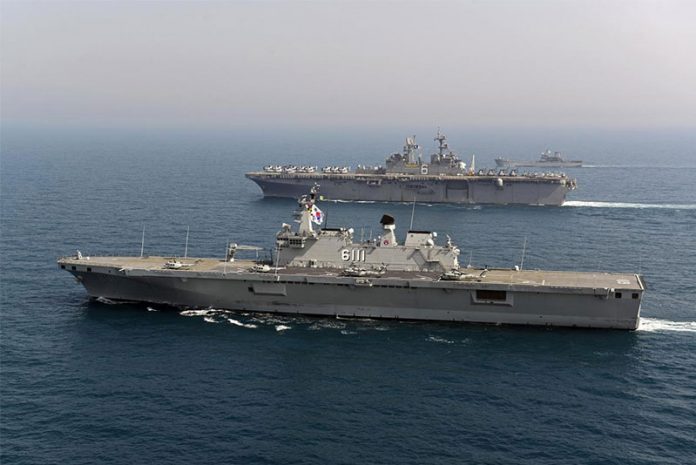 |
| Dokdo-class vessels
The Republic of Korea (ROK) recently announced that it plans to launch by 2030 a large-deck amphibious-warfare ship that could handle Short Take Off and Vertical Landing (STOVL) aircraft.
With a displacement of 30,000 tons, the new Landing Platform Helicopter (LPH) is over twice the size of its predecessors, the 14,500-ton Dokdo-class vessels, and is expected to have significantly more capabilities. For instance, its aviation complement could number 20 STOVL jets (likely to be the Lockheed Martin F-35B Lightning) on top of other air assets, and this is a step-change from the Dokdos with their dozen helicopters. This development is part of an ambitious five-year naval build-up unveiled in mid-August that includes ballistic missile defence-capable Arleigh Burke type Aegis destroyers and submarines armed for land attack. LPX-II, the official name for the ROK’s new capital ship, marks the first time the republic is pursuing a true aircraft carrier-type platform. What then are the main drivers behind this keystone acquisition?
South Korea’s Ministry of National Defence stated in no uncertain terms that the naval build-up has North Korea in mind. Indeed, its northern neighbour has been an existential threat for much of its history. Should a second Korean War break out, ROK airfields could be prime targets for the much-feared artillery, tactical ballistic missiles, and special operations forces of the Korea’s People Army (KPA). Having a carrier force would mitigate this threat. Should its land bases be knocked out, South Korea could turn to sea-based airpower for one of its ‘second-strike’ options. it could be argued that the relatively small air wing of an LPX-II militates against it shaping the battlespace to any significant degree. However, this line of reasoning ignores the fact that the flat-top could bring about disproportionate strategic effects. A carrier force could use its mobility and speed to complicate the enemy’s calculus, and trying to locate one (or two) of them roaming off the North Korean coasts in the Japan and Yellow Seas is essentially trying to find a needle in the haystack. Matters are not helped by the KPA’s anaemic naval and air-defence capabilities.
Another driver behind the LPX-II acquisition would be the increasing uncertainty clouding the north-east Asian geo-strategic environment. China is becoming increasingly assertive in its environs and the People’s Liberation Army-Navy (PLAN) is growing from strength to strength. In addition, South Korea’s ties with Japan are at its lowest ebb in recent times. In August, the ROK ended a military intelligence-sharing deal with Japan in a tit-for-tat move against trade sanctions imposed by Tokyo a month earlier. Soon after the termination of the deal, the South Korean military launched an exercise aimed at demonstrating control over the Dokdos that Japan also claims. Even though these islets are within range of South Korean land-based aircraft, the highly maritime nature of this spat means that there would be a premium placed on sea-based airpower during any crisis. For instance, the latter offers various tactical advantages over its shore-based counterpart, such as longer loiter time in the area of operations. It also bears consideration that the LPX-II was revealed after Japan said its Izumo-class “helicopter destroyers” could be converted to carriers. And just over a week after the LPX-II’s unveiling, Tokyo officially announced that it will buy the F-35B from the United States. Are these developments too much of a coincidence perhaps?
All in all, continual inter-state tensions are probably the main factor driving South Korea’s aircraft carrier ambitions. Moreover, with the ROK gazing increasingly towards the ‘blue waters’ and concomitantly out-of-area operations, having a carrier would stand South Korea in good stead should it partake in a major humanitarian-assistance/disaster-relief mission given that the vessel could then be a key node in such an operation. In summery, the utility of a carrier-like platform invariably expands a nation’s military toolbox, and it makes for a good hedge against the uncertainties of the regional security environment. There is arguably a prestige element to the LPX-II acquisition as well. Flat-tops are the ‘Queen of the Waves’, and owning (and being able to operate) them invariably adds to a country’s standing amongst the league of nations. Indeed, possessing an aircraft carrier seems to be par the course for medium powers these days, with the likes of Australia, India and Japan already having or working towards such a capability. While South Korea’s current Dokdo-class vessels are certainly aviation-capable, they are too small in size and too limited in capability to be categorised even as ‘quasi-carriers’. The LPX-II, however, would change that state of affairs.
|
Friday, October 4, 2019
South Korea joins Asia’s Carrier Race
Ben Ho
Reinventing the Small Wind Turbine
Many commercially available small wind turbines with plastic blades and steel towers are infamous for their low reliability, high embodied energy, and limited power output.
Building them out of wood can address these issues. Because of their aesthetic appeal, and thanks to the ability to produce them locally, small wooden wind turbines can also improve the public acceptance of wind power.
Furthermore, innovation in tower design facilitates the installation of small wind turbines, reducing the need for concrete foundations and heavy machinery.
Image: A wind turbine with wooden blades. Source: EAZ Wind.
Subscribe to:
Posts (Atom)